MERCEDES-BENZ SLC ROADSTER 2018 Owner's Manual
Manufacturer: MERCEDES-BENZ, Model Year: 2018, Model line: SLC ROADSTER, Model: MERCEDES-BENZ SLC ROADSTER 2018Pages: 298, PDF Size: 5.26 MB
Page 271 of 298
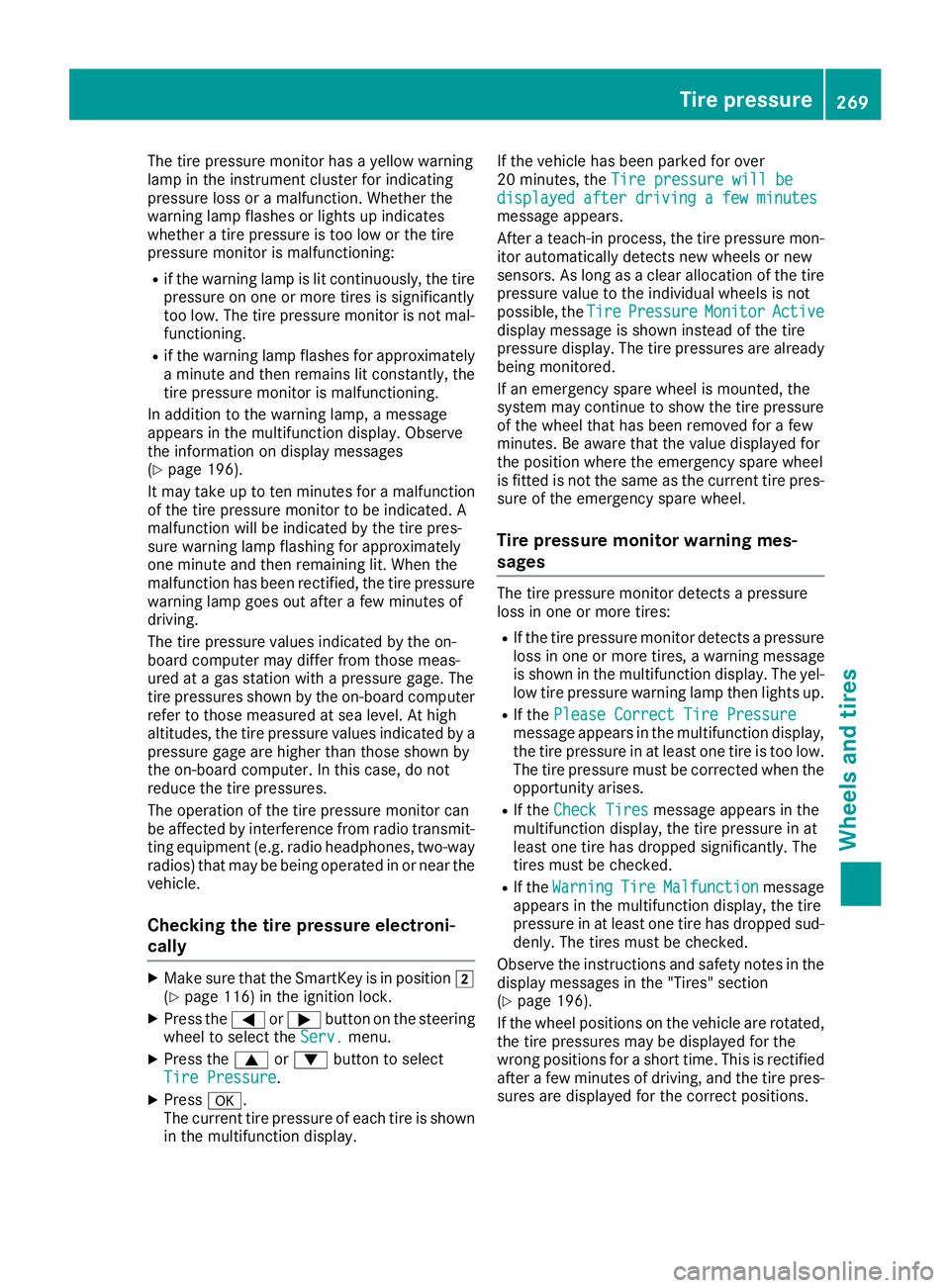
The tire pressure monitor hasayellow warning
lamp in the instrument cluster for indicating
pressure loss or amalfunction. Whether the
warning lamp flashes or lights up indicates
whether atire pressure is too low or the tire
pressure monitor is malfunctioning:
Rif the warning lamp is lit continuously, the tire
pressure on one or more tires is significantly
too low. The tire pressure monitor is not mal- functioning.
Rif the warning lamp flashes for approximately
am inute and then remains lit constantly, the
tire pressure monitor is malfunctioning.
In addition to the warning lamp, amessage
appears in the multifunction display.O bserve
the information on display messages
(
Ypage 196).
It may take up to ten minutes for amalfunction
of the tire pressure monitor to be indicated. A
malfunction will be indicated by the tire pres-
sure warning lamp flashing for approximately
one minute and then remaining lit. When the
malfunction has been rectified, the tire pressure
warning lamp goes out after afew minutes of
driving.
The tire pressure values indicated by the on-
board computer may differ from those meas-
ured at agas station with apressure gage. The
tire pressures shown by the on-board computer
refer to those measured at sea level. At high
altitudes, the tire pressure values indicated by a pressure gage are higher than those shown by
the on-board computer. In this case, do not
reduce the tire pressures.
The operation of the tire pressure monitor can
be affected by interferenc efrom radio transmit-
ting equipment (e.g. radio headphones, two-way
radios) that may be being operated in or near the vehicle.
Checking the tire pressur eelectroni-
cally
XMake sure that the SmartKey is in position 2
(Ypage 116) in the ignition lock.
XPress the =or; button on the steering
wheel to select the Serv.menu.
XPress the9or: button to select
Tire Pressure.
XPress a.
The current tire pressure of each tire is shown
in the multifunction display. If the vehicle has been parked for over
20 minutes, the
Tire pressure will be
displayed after driving afew minutesmessage appears.
After ateach-in process, the tire pressure mon-
itor automatically detect snew wheels or new
sensors. As long as aclear allocation of the tire
pressure value to the individual wheels is not
possible, the Tire
PressureMonitorActivedisplay message is shown instead of the tire
pressure display.T he tire pressures are already
being monitored.
If an emergencys pare wheel is mounted, the
system may continue to show the tire pressure
of the wheel that has been removed for afew
minutes. Be aware that the value displayed for
the position where the emergencys pare wheel
is fitted is not the same as the current tire pres-
sure of the emergencys pare wheel.
Tire pressuremonitor warning mes-
sages
The tire pressure monitor detect sapressure
loss in one or more tires:
RIf the tire pressure monitor detect sapressure
loss in one or more tires, awarning message
is shown in the multifunction display.T he yel-
low tire pressure warning lamp then lights up.
RIf the Please Correct Tire Pressuremessage appears in the multifunction display,
the tire pressure in at least one tire is too low.
The tire pressure must be corrected when the
opportunit yarises.
RIf the Check Tiresmessage appears in the
multifunction display,t he tire pressure in at
least one tire has dropped significantly. The
tires must be checked.
RIf the WarningTireMalfunctionmessage
appears in the multifunction display,t he tire
pressure in at least one tire has dropped sud-
denly. The tires must be checked.
Observe the instructions and safety notes in the
display messages in the "Tires" section
(
Ypage 196).
If the wheel positions on the vehicle are rotated,
the tire pressures may be displayed for the
wrong positions for ashort time. This is rectified
after afew minutes of driving, and the tire pres-
sures are displayed for the correctp ositions.
Tirepressure269
Wheels and tires
Z
Page 272 of 298
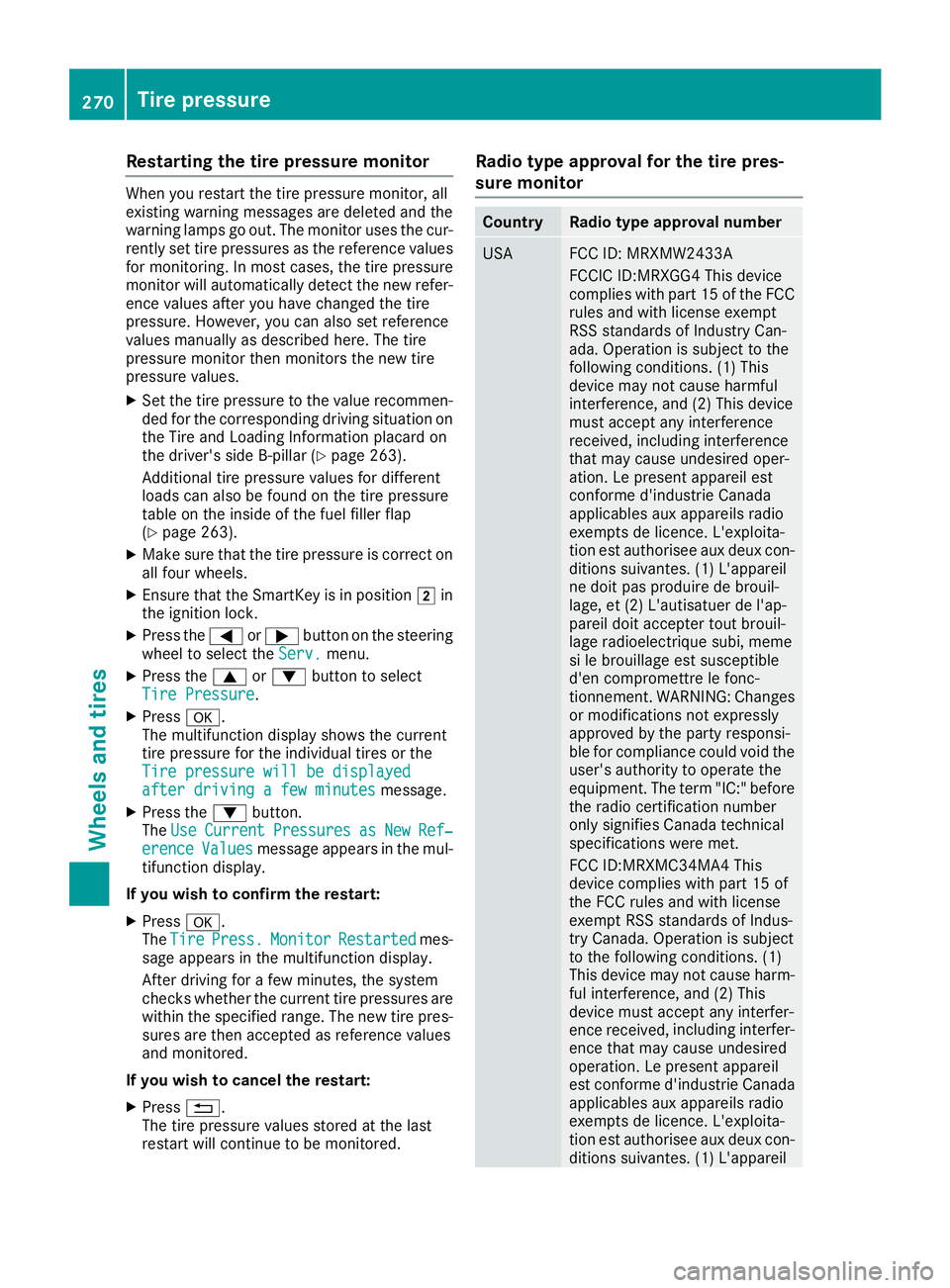
Restarting the tire pressure monitor
Whenyourestart the tire pressure monitor, all
existing warning messages are deleted and the
warning lamps go out. The monitor uses the cur-
rentlys et tire pressures as the reference values
for monitoring. In most cases, the tire pressure
monitor will automaticall ydetect the new refer-
ence value safteryou have changed the tire
pressure. However, yo ucan also set reference
value smanually as described here. The tire
pressure monitor then monitors the new tire
pressure values.
XSet the tire pressure to the value recommen-
ded for the corresponding driving situation on
the Tire and Loading Information placard on
the driver'ss ideB -pillar (
Ypage 263).
Additiona ltire pressure value sfor different
load scan also be found on the tire pressure
table on the inside of the fue lfille rflap
(
Ypage 263).
XMake sure that the tire pressure is correct on
al lf ourw heels.
XEnsur ethat the SmartKey is in position 2in
the ignition lock.
XPress the =or; button on the steering
wheel to select the Serv.menu.
XPress the9or: button to select
Tire Pressure.
XPress a.
The multifunction display shows the current
tire pressure for the individual tire sorthe
Tire pressure will be displayed
afterd rivingafew minutesmessage.
XPress the :button.
The UseCurrentPressuresasNewRef‐erenceValuesmessage appears in the mul-
tifunction display.
If you wish to confirm the restart:
XPress a.
The TirePress.MonitorRestartedmes-
sage appears in the multifunction display.
After driving for afew minutes, the system
checks whethert he current tire pressures are
within the specified range. The new tire pres-
sures are then accepted as reference values
and monitored.
If you wish to cance lthe restart:
XPress %.
The tire pressure value sstoredatt he last
restart will continu etobemonitored.
Radio type approval for the tire pres-
sure monitor
CountryRadio type approval number
USAFCC ID: MRXMW2433A
FCCIC ID:MRXGG4 Thisd evice
complies with part 15 of the FCC
rules and with license exempt
RSS standard sofIndustry Can-
ada. Operation is subject to the
following conditions .(1) This
device may not cause harmful
interference, and (2) Thisd evice
mus taccept any interference
received, including interference
that may cause undesired oper-
ation. Le present appareile st
conforme d'industrieC anada
applicables au xappar eils radio
exempts de licence. L'exploita-
tion est authorisee au xdeuxc on-
ditions suivantes. (1) L'appareil
ne doi tpas produire de brouil-
lage, et (2) L'autisatue rdel'ap-
pareild oita ccepter toutb rouil-
lage radioelectriqu esubi, meme
si le brouillag eest susceptible
d'e ncompromettre le fonc-
tionnement. WARNING:C hanges
or modifications not expressly
approved by the party responsi-
bl ef or compliance could voidt he
user'sa uthority to operate the
equipment. The term "IC:" before the radio certification number
only signifies Canad atechnical
specifications were met.
FCC ID:MRXMC34MA4 This
device complies with part 15 of
the FCC rules and with license
exempt RSS standard sofIndus-
try Canada. Operation is subject
to the following conditions .(1)
Thisd evice may not cause harm-
ful interference, and (2) This
device mus taccept any interfer-
ence received, inclu
ding interfer-
ence that may cause undesired
operation. Le present appareil
est conforme d'industrieC anada
applicables au xappar eils radio
exempts de licence. L'exploita-
tion est authorisee au xdeuxc on-
ditions suivantes. (1) L'appareil
270Tire pressure
Wheel sand tires
Page 273 of 298
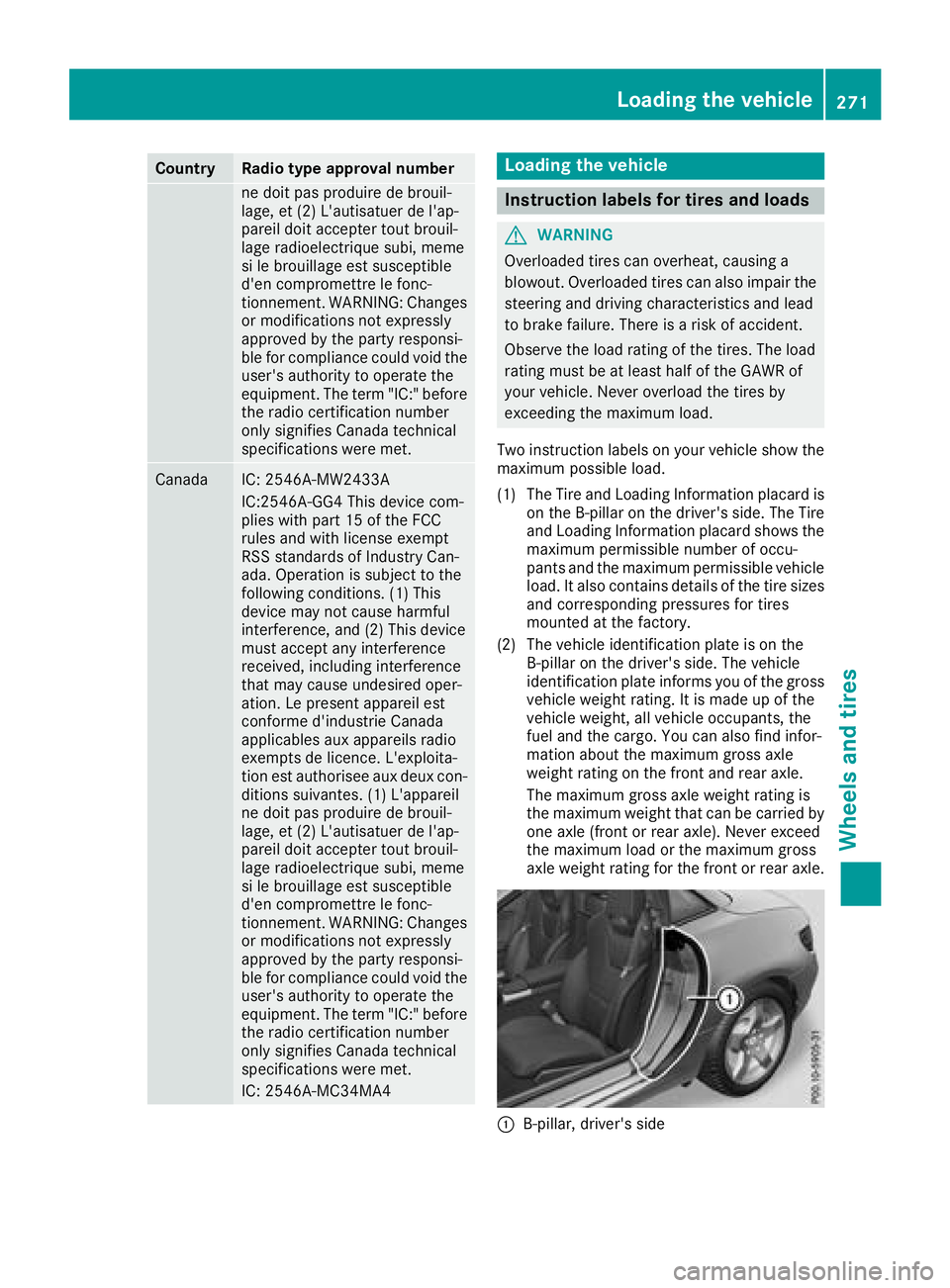
CountryRadio type approval number
ne doit pas produire de brouil-
lage, et (2) L'autisatuer de l'ap-
pareil doit accepter tout brouil-
lage radioelectrique subi, meme
si le brouillage est susceptible
d'en compromettre le fonc-
tionnement. WARNING: Changes
or modifications not expressly
approved by thepartyr esponsi-
ble for compliance could void the
user'sa uthorityt ooperate the
equipment .The ter m"IC:"b efore
th er adio certification number
onl ysignifies Canada technical
specifications were met.
CanadaIC: 2546A-MW2433A
IC:2546A-GG4 This devic ecom-
plies with part 15 of th eFCC
rules and with licens eexempt
RSS standards of Industry Can-
ada. Operatio nissubject to the
following conditions. (1) This
devic emay not cause harmful
interference, and (2) This device
must accept any interference
received ,includingi nterference
that may cause undesiredo per-
ation. Le present appareil est
conforme d'industrie Canada
applicables aux appareils radio
exemptsdel icence. L'exploita-
tio ne st authorisee aux deux con-
ditionss uivantes.(1) L'appareil
ne doit pas produire de brouil-
lage, et (2) L'autisatuer de l'ap-
pareil doit accepter tout brouil-
lage radioelectrique subi, meme
si le brouillage est susceptible
d'en compromettre le fonc-
tionnement. WARNING: Changes
or modifications not expressly
approved by th epartyr esponsi-
ble for compliance could void the
user'sa uthorityt ooperate the
equipment .The ter m"IC:"b efore
th er adio certification number
onl ysignifies Canada technical
specifications were met.
IC: 2546A-MC34MA4
Loading th evehicle
Instruction labels for tires and loads
GWARNING
Overloadedt ires can overheat,c ausing a
blowout.O verloadedt ires can also impair the
steeringa nd driving characteristic sand lead
to brakef ailure. Thereisar isk of accident.
Observe th eload rating of th etires. The load
rating must be at least half of th eGAWR of
your vehicle .Never overload th etires by
exceedingt hemaximum load.
Two instruction labels on your vehicle show the maximum possible load.
(1) The Tire and LoadingI nformation placar dis
on th eB-pillar on th edriver' sside. The Tire
and LoadingI nformation placar dshows the
maximum permissible number of occu-
pant sand th emaximum permissible vehicle
load. It also contain sdetails of th etires izes
and corresponding pressures for tires
mounted at th efactory.
(2) The vehicle identification plateisont he
B-pillar on th edriver' sside. The vehicle
identification platei nformsyou of thegross
vehicle weight rating .Itismade up of the
vehicle weight,a ll vehicle occupants, the
fuel and th ecargo. You can also fin dinfor-
mation about th emaximum gross axle
weight rating on th efront and rear axle.
The maximum gross axle weight rating is
th em aximum weight that can be carried by
one axle (front or rear axle) .Never exceed
th em aximum load or th emaximum gross
axle weight rating for th efront or rear axle.
:B-pillar ,driver' sside
Loading th evehicle271
Wheels and tires
Z
Page 274 of 298
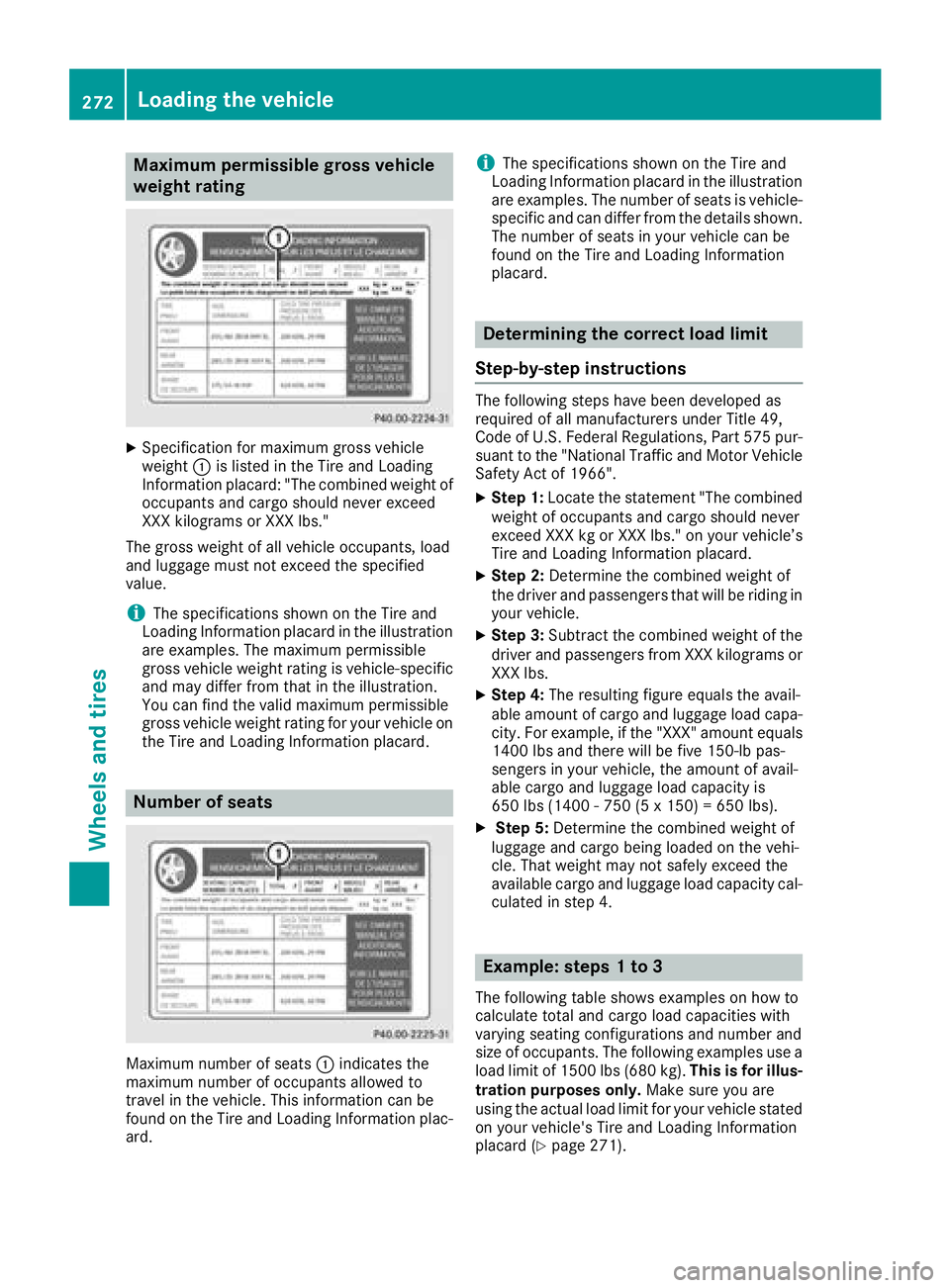
Maximum permissible gross vehicle
weight rating
XSpecification for maximumgross vehicle
weight :is listed in the Tire and Loading
Informatio nplacard: "The combined weight of
occupants and cargo should never exceed
XXX kilograms or XXX lbs."
The gross weight of all vehicleo ccupants, load
and luggage must not exceed the specified
value.
iThe specifications shownont he Tire and
Loading Informatio nplacard in the illustration
are examples. The maximu mpermissible
gross vehiclew eight rating is vehicle-specific
and may differf rom that in the illustration.
You can find the vali dmaximu mpermissible
gross vehiclew eight rating for you rvehicleo n
the Tire and Loading Informatio nplacard.
Number of seats
Maximu mnumber of seats :indicates the
maximu mnumber of occupants allowedt o
travel in the vehicle. This information can be
found on the Tire and Loading Informatio nplac-
ard.
iThe specifications shownont he Tire and
Loading Informatio nplacard in the illustration
are examples. The number of seats is vehicle-
specific and can differf rom the details shown.
The number of seats in you rvehiclec an be
found on the Tire and Loading Information
placard.
Determiningt he correct load limit
Step-by-ste pinstructions
The following steps have been developed as
required of all manufacturers under Title 49,
Cod eofU .S. FederalR egulations, Part 575 pur-
suant to the "National Traffi cand Motor Vehicle
Safety Act of 1966".
XStep 1: Locate the statement "The combined
weight of occupants and cargo should never
exceed XXX kg or XXX lbs." on you rvehicle’s
Tire and Loading Informatio nplacard.
XStep 2: Determine the combined weight of
the drivera nd passengers that wil lberiding in
you rvehicle.
XStep 3: Subtract the combined weight of the
drivera nd passengers from XXX kilograms or
XXX lbs.
XStep 4: The resulting figure equals the avail-
abl eamount of cargo and luggage loadc apa-
city. For example, if the "XXX "amount equals
1400 lbs and there wil lbefive 150-lb pas-
sengers in you rvehicle, the amount of avail-
abl ecargo and luggage loadc apacity is
650 lbs (1400 -750 (5 x150) = 650 lbs).
XStep 5: Determine the combined weight of
luggage and cargo being loaded on the vehi-
cle. That weight may not safel yexceed the
available cargo and luggage loadc apacity cal-
culated in step 4.
Example:s teps1to3
The following table showse xamples on how to
calculate total and cargo loadc apacities with
varying seating configurations and number and
size of occupants. The following examples use a
loadl imitof1 500 lbs (680 kg). This is for illus-
tration purposes only. Make sure you are
using the actua lloadl imitf or you rvehicles tated
on you rvehicle's Tire and Loading Information
placard (
Ypage2 71).
272Loading the vehicle
Wheels and tires
Page 275 of 298
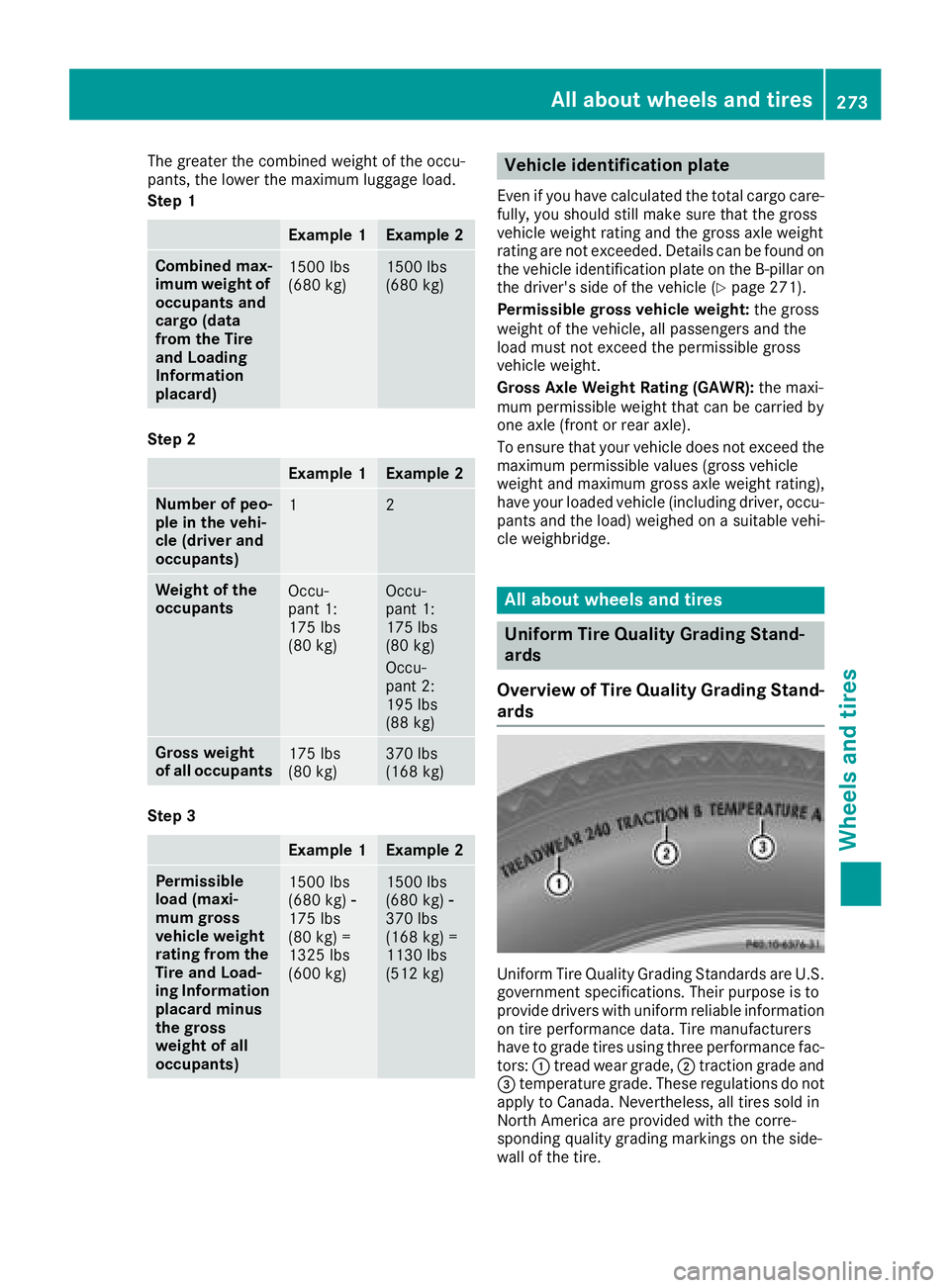
The greater the combined weight of the occu-
pants, the lower the maximum luggage load.
Step 1
Example 1Example 2
Combined max-
imum weight of
occupants and
cargo (data
from the Tire
and Loading
Information
placard)1500 lbs
(680 kg)1500 lbs
(680 kg)
Step 2
Example 1Example 2
Number of peo-
ple in the vehi-
cle (driver and
occupants)12
Weight of the
occupantsOccu-
pant 1:
175 lbs
(80 kg)Occu-
pant 1:
175 lbs
(80 kg)
Occu-
pant 2:
195 lbs
(88 kg)
Gross weight
of all occupants175 lbs
(80 kg)370 lbs
(168 kg)
Step 3
Example 1Example 2
Permissible
load (maxi-
mum gross
vehicle weight
rating from the
Tire and Load-
ing Information
placardminus
the gross
weight of all
occupants)1500 lbs
(680 kg) Ò
175 lbs
(80 kg) =
1325 lbs
(600 kg)1500 lbs
(680 kg) Ò
370 lbs
(168 kg) =
1130 lbs
(512 kg)
Vehicle identification plate
Even if you have calculated the total cargo care-
fully, you should still make sure that the gross
vehicle weight rating and the gross axle weight
rating are not exceeded. Details can be found on
the vehicle identification plate on the B-pillar on
the driver's side of the vehicle (
Ypage 271).
Permissible gross vehicle weight: the gross
weight of the vehicle, all passengers and the
load must not exceed the permissible gross
vehicle weight.
Gross Axle Weight Rating (GAWR): the maxi-
mum permissible weight that can be carried by
one axle (front or rear axle).
To ensure that your vehicle does not exceed the
maximum permissible values (gross vehicle
weight and maximum gross axle weight rating),
have your loaded vehicle (including driver, occu-
pants and the load) weighed on asuitable vehi-
cle weighbridge.
All about wheels and tires
Uniform Tire Quality Grading Stand-
ards
Overview of Tire Quality Grading Stand-
ards
Uniform Tire Quality Grading Standards are U.S. government specifications. Their purpose is to
provide drivers with uniform reliable information
on tire performance data. Tire manufacturers
have to grade tires using three performance fac-
tors: :tread wear grade, ;traction grade and
= temperature grade. These regulations do not
apply to Canada. Nevertheless, all tires sold in
North Americaa re provided with the corre-
sponding quality grading markings on the side-
wall of the tire.
All about wheelsa nd tires273
Wheels and tires
Z
Page 276 of 298
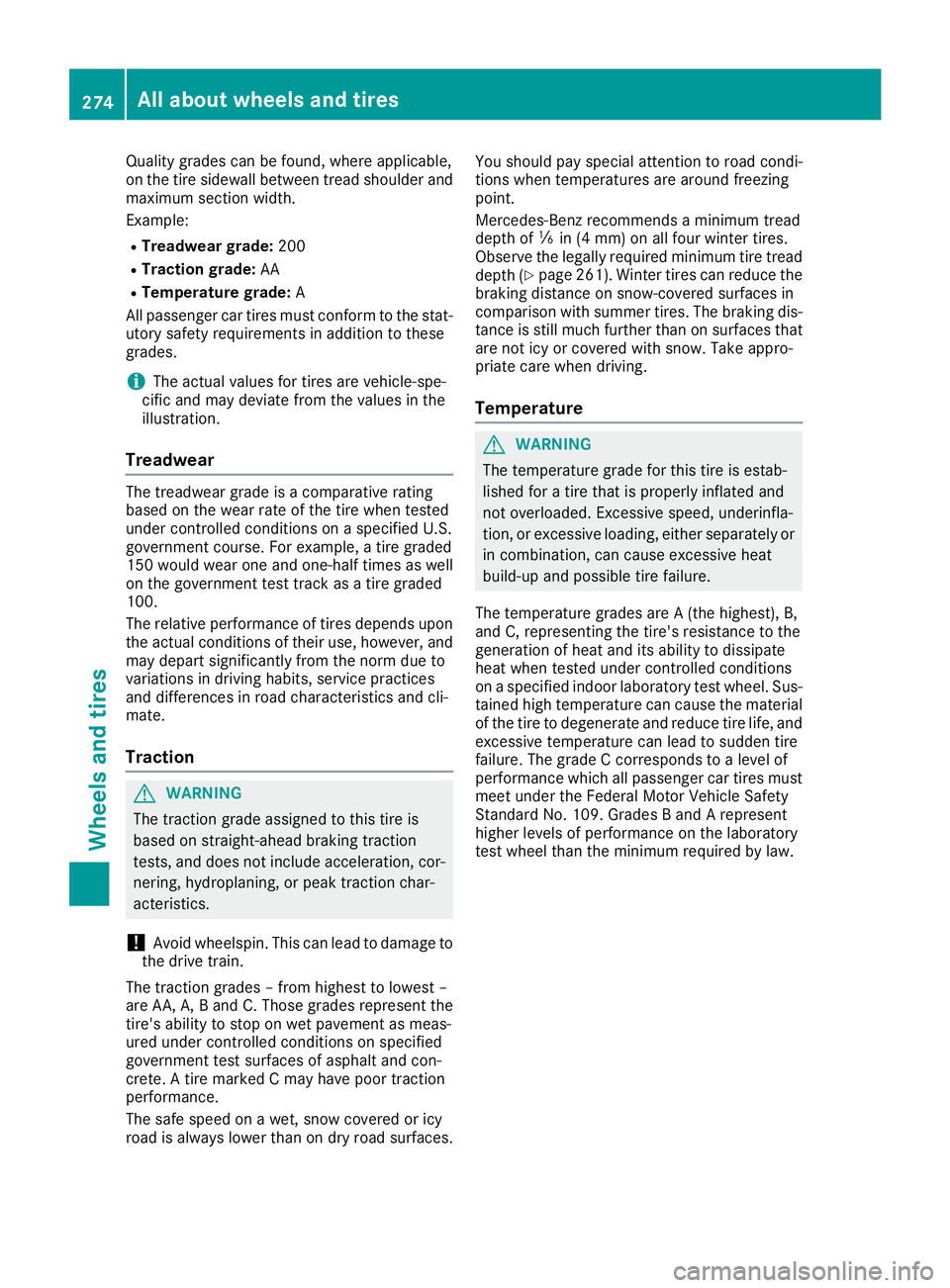
Quality grades can be found,where applicable,
on the tire sidewall between tread shoulde rand
maximum sectio nwidth.
Example:
RTreadwear grade: 200
RTractiongrade: AA
RTemperature grade: A
All passengerc ar tires must conform to the stat-
utory safety requirements in additio ntothese
grades.
iThe actua lvalues for tires are vehicle-spe-
cific and may deviate from the values in the
illustration.
Treadwear
The treadwea rgrad eisac omparativ erating
based on the wea rrate of the tire whe ntested
unde rcontrolled conditions on aspecified U.S.
government course. For example, atire graded
150 would wea rone and one-half times as well
on the government test track as atire graded
100.
The relative performance of tires depends upon
the actua lconditions of their use ,however, and
may depart significantly from the norm duet o
variations in driving habits, service practices
and differences in road characteristics and cli-
mate.
Traction
GWARNING
The tractio ngrad eassignedtot his tire is
based on straight-ahead braking traction
tests, and doesn ot include acceleration, cor-
nering, hydroplaning ,orpeaktractio nchar-
acteristics.
!Avoid wheelspin. Thisc an leadtodamage to
the driv etrain.
The tractio ngrades –from highest to lowest –
are AA, A, Band C. Thoseg rades represent the
tire's ability to stop on wet pavement as meas-
ure dunde rcontrolled conditions on specified
government test surfaces of asphal tand con-
crete. Atire marked Cmay have poort raction
performance.
The safe speedonaw et, snow coveredoricy
road is always lower than on dry road surfaces. You should pay speciala
ttentiontoroadc ondi-
tions whe ntemperatures are around freezing
point.
Mercedes-Benz recommends aminimum tread
depth of ãin (4 mm )onallfour winter tires.
Observe the legally required minimum tire tread
depth (
Ypag e261). Winter tires can reduce the
braking distance on snow-covered surfaces in
comparisonw iths ummer tires. The braking dis-
tance is stil lmuch furthe rthan on surfaces that
are not icy or coveredw iths now. Take appro-
priate care whe ndriving.
Temperature
GWARNING
The temperature grad efor this tire is estab-
lished for atire that is properly inflated and
not overloaded. Excessiv espeed, underinfla-
tion, or excessive loading ,eithers eparately or
in combination, can cause excessive heat
build-up and possibl etire failure.
The temperature grades are A(the highest),B ,
and C, representing the tire's resistance to the
generation of heata nd its ability to dissipate
heatw hent ested unde rcontrolled conditions
on aspecified indoor laboratory test wheel. Sus-
taine dhight emperature can cause the material
of the tire to degenerate and reduce tire life, and
excessive temperature can leadtos udden tire
failure. The grad eCcorresponds to aleve lof
performance which al lpassengerc ar tires must
meet unde rthe Federal Motor Vehicle Safety
Standard No. 109. Grades BandArepresent
higher levels of performance on the laboratory
test wheel than the minimum required by law.
274Al la bout wheelsa nd tires
Wheels and tires
Page 277 of 298
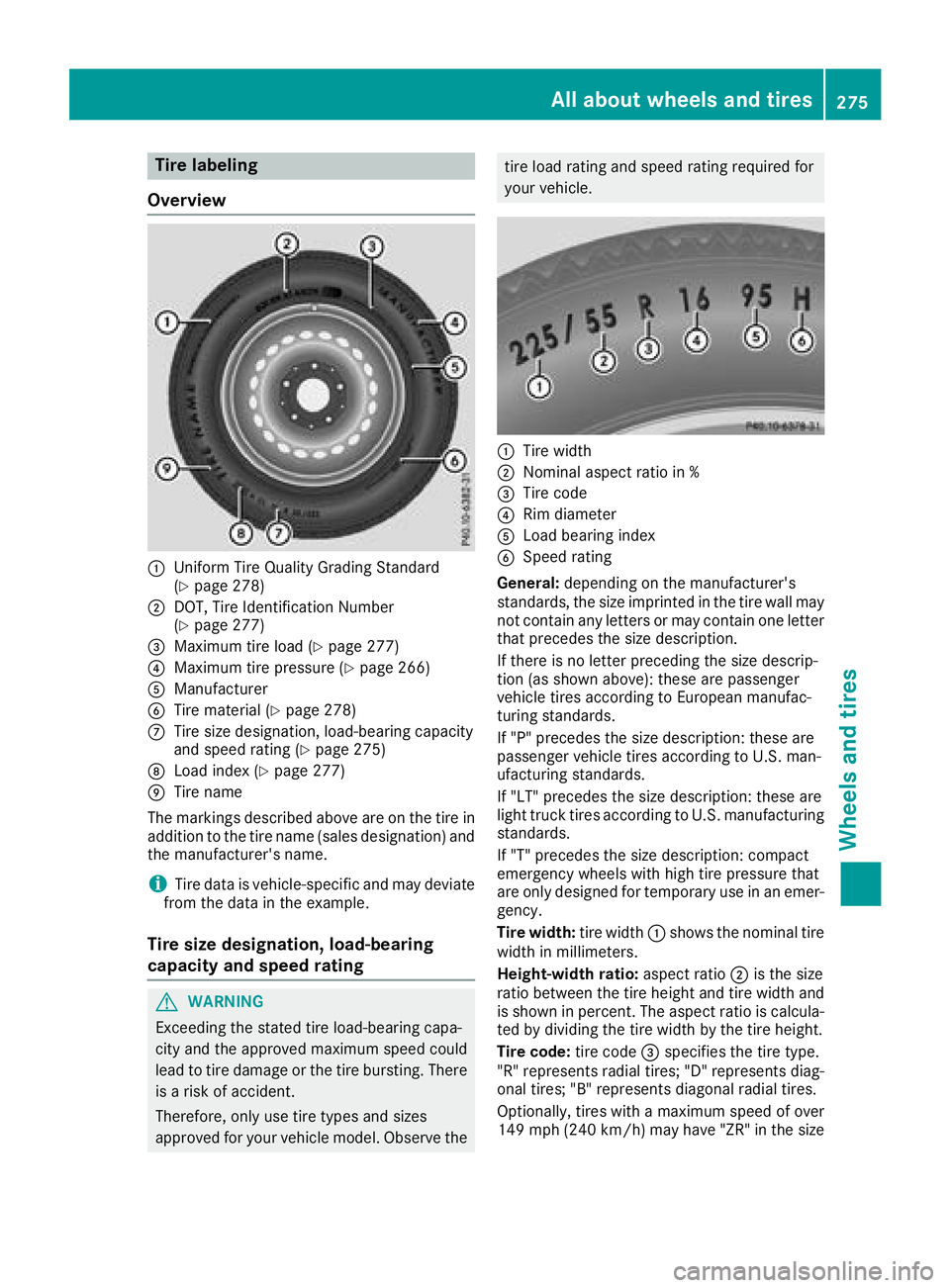
Tire labeling
Overview
:Unifor mTireQ ualit yGradin gStandard
(Ypage 278)
;DOT, Tire Identification Number
(Ypage 277)
=Maximum tire load (Ypage 277)
?Maximum tire pressure (Ypage 266)
AManufacturer
BTire material (Ypage 278)
CTire size designation, load-bearing capacity
and spee drating (Ypage 275)
DLoadi ndex (Ypage 277)
ETire name
The markings describe dabove ar eont he tire in
additio ntothe tire nam e(sales designation) and
the manufacturer's name.
iTire data is vehicle-specific and mayd eviate
fromt he data in the example.
Tire size designation ,loa d-bearing
capacity and speed rating
GWARNING
Exceeding the stated tire load-bearing capa-
city and the approved maximum spee dcould
lead to tire damage or the tire bursting. There is ar iskofa ccident.
Therefore ,onlyu setire types and sizes
approved for your vehicl emodel .Observe the
tire load rating and spee drating required for
your vehicle.
:Tire width
;Nomina laspec tratio in %
=Tire code
?Rimd iame ter
ALoadb earing index
BSpeed rating
General: depending on the manufacturer's
standards ,the size imprinted in the tire wall may
not contain any letters or mayc ontain one letter
thatp recedes the size description.
If there is no letter preceding the size descrip-
tio n(as shown above): these ar epassenger
vehicl etiresa ccording to Europea nmanufac-
turing standards.
If "P "precedes the size description: these are
passenge rvehicl etiresa ccording to U.S. man-
ufacturin gstandards.
If "LT" precedes the size description: these are
light truck tire saccording to U.S. manufacturing
standards.
If "T "precedes the size description: compact
emergency wheels with high tire pressure that
ar eo nlyd esig nedf or temporary us einanemer-
gency.
Tire width: tire width:shows the nominal tire
width in millimeters.
Height-width ratio: aspect ratio;is the size
ratio between the tire height and tire width and
is shown in percent. The aspect ratio is calcula-
ted by dividing the tire width by the tire height.
Tire code: tire code=specifie sthe tire type.
"R "r epresents radial tires; "D" represents diag-
ona ltire s; "
B" represents diagona
lradial tires.
Optionally ,tire sw itham aximum spee dofover
149 mph (24 0km/h )mayhave "ZR" in the size
Alla bout wheels an dtires275
Wheel sand tires
Z
Page 278 of 298
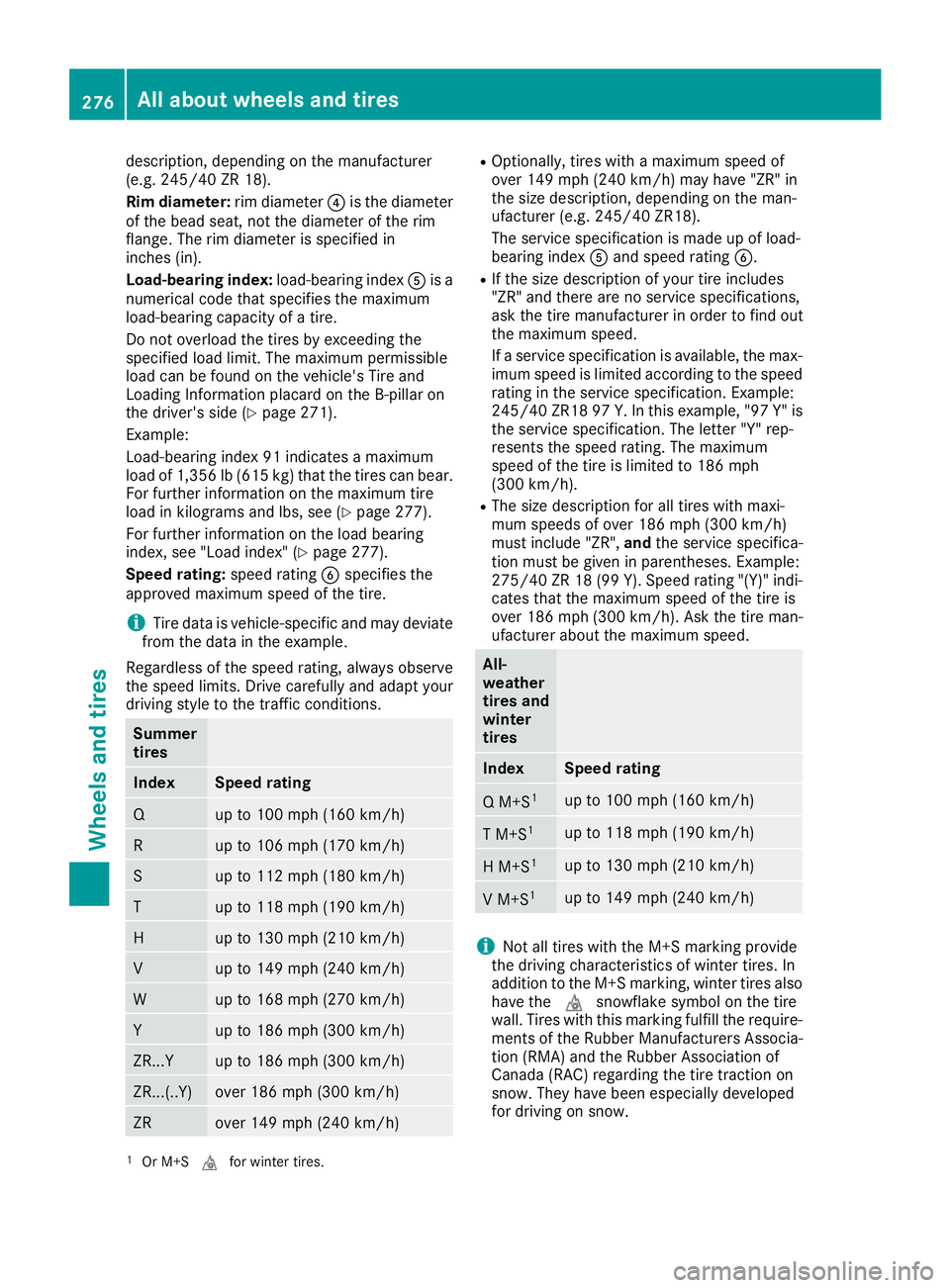
description, dependingonthe manufacturer
(e.g. 245/40 ZR 18).
Rim diameter: rim diameter?is the diameter
of the bead seat, not the diameter of the rim
flange. The rim diameter is specified in
inches (in).
Load-bearing index: load-bearing indexAis a
numerical code that specifies the maximum
load-bearing capacityofat ire.
Do not overload the tires by exceeding the
specified load limit. The maximum permissible
load can be found on the vehicle's Tire and
Loading Information placard on the B-pillar on
the driver'ss ide (
Ypage 271).
Example:
Load-bearin gindex 91 indicates amaximum
load of 1,356lb( 615 kg) that the tires can bear.
For further information on the maximum tire
load in kilograms and lbs, see (
Ypage 277).
For further information on the load bearing
index ,see "Load index "(
Ypage 277).
Speed rating: speed ratingBspecifies the
approved maximum speed of the tire.
iTire data is vehicle-specific and may deviate
from the data in the example.
Regardless of the speed rating, always observe
the speed limits. Driv ecarefully and adapt your
driving style to the traffic conditions.
Summer
tires
IndexSpeed rating
Qup to 100 mph (160 km/h)
Rup to 106 mph (170 km/h)
Sup to 112 mph (180 km/h)
Tup to 118 mph (190 km/h)
Hup to 130 mph (210 km/h)
Vup to 149 mph (240 km/h)
Wup to 168 mph (270 km/h)
Yup to 186 mph (300 km/h)
ZR...Yup to 186 mph (300 km/h)
ZR...(..Y)over 186 mph (300 km/ h)
ZRover 149 mph (240 km/h)
ROptionally, tires withamaximum speed of
over 149 mph (240k m/h) may have "ZR" in
the sized escription, depending on the man-
ufacturer (e.g .245/4 0ZR18).
The service specification is made up of load-
bearingi ndexAand speed rating B.
RIf the sizedescription of your tir eincludes
"ZR" and there are no service specifications,
ask the tir emanufacturer in order to findo ut
the maximum speed.
If as ervice specification is available, the max-
imum speed is limited accordingtot he speed
rating in the service specification .Example:
245/4 0ZR18 97 Y. In this example, "97 Y" is
the service specification .The letter "Y" rep-
resent sthe speed rating. The maximum
speed of the tir eislimited to 186 mph
(300k m/h).
RThe sized escription for all tires with maxi-
mum speeds of over 186 mph (300k m/h)
must include "ZR", andthe service specifica-
tion must be given in parentheses. Example:
275/4 0ZR18( 99 Y). Spee drating "(Y)" indi-
cates that the maximum speed of the tir eis
over 186 mph (300k m/h).A sk the tir eman-
ufacturer about the maximum speed.
All-
weather
tires and
winter
tires
IndexSpeed rating
QM +S1up to 100 mph (160k m/h)
TM +S1up to 118 mph (190k m/h)
HM +S1up to 130 mph (210k m/h)
VM +S1up to 149 mph (240k m/h)
iNot all tires with the M+S marking provide
the driving characteristics of winter tires. In
additio ntothe M+S marking, winter tires also
have the isnowflakes ymbol on the tire
wall. Tires with this marking fulfill the require-
ments of the Rubber Manufacturers Associa-
tion (RMA) and the Rubber Association of
Canada (RAC) regarding the tir etraction on
snow. They have been especially developed
for driving on snow.
1Or M+S ifor winter tires.
276All about wheels and tires
Wheels and tires
Page 279 of 298
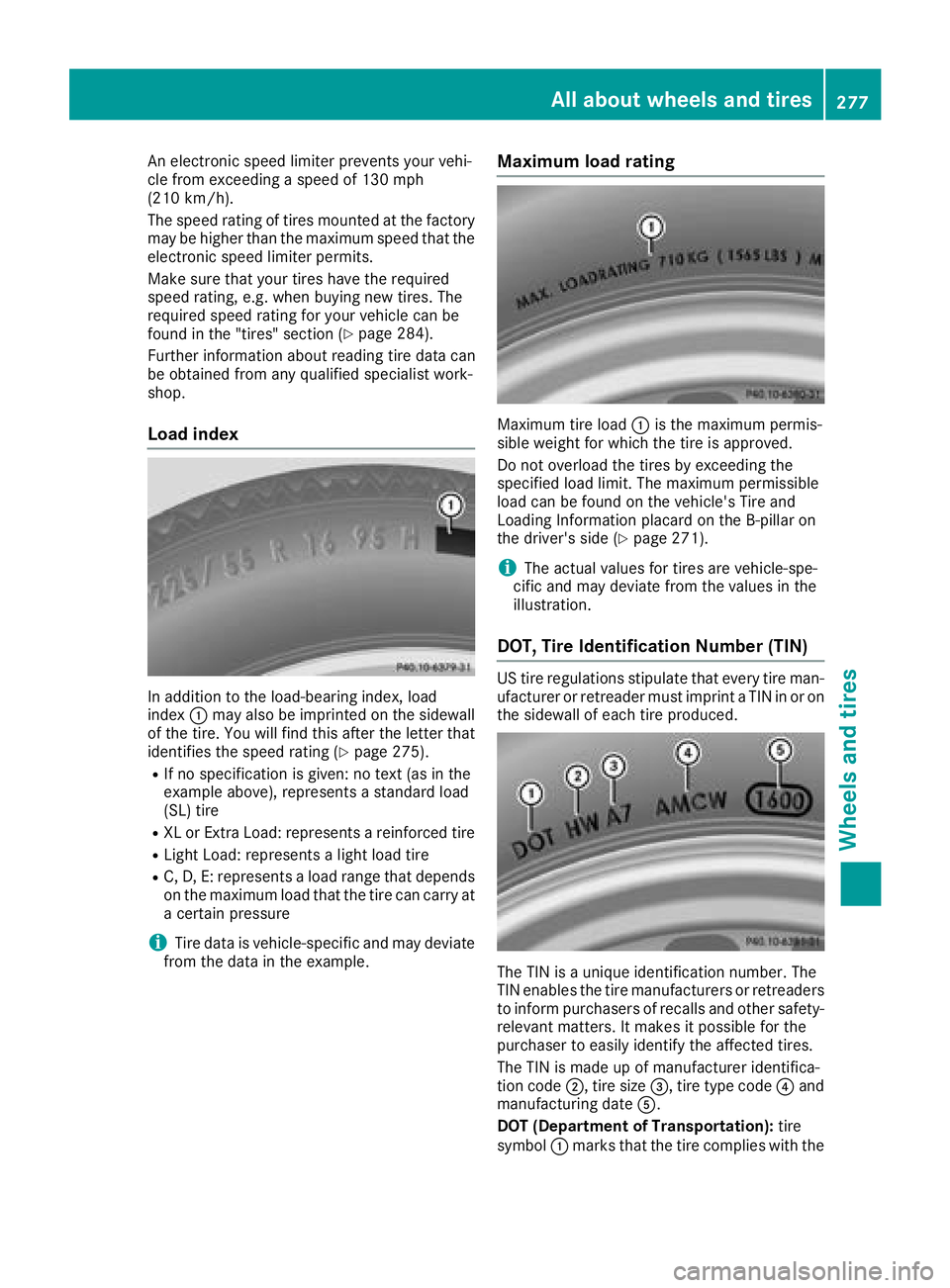
An electronic speed limiterprevents your vehi-
cle from exceeding aspeed of 130 mph
(21 0km/h).
The speed rating of tire smounted at the factory
maybeh ighe rthant he maximu mspeed thatt he
electronic speed limite rpermits.
Make sure thaty ourtire sh avet he required
speed rating ,e.g.w henb uyin gnew tires. The
required speed rating for your vehicl ecan be
found in the "tires "sectio n(
Ypage 284).
Further informatio nabout reading tire data can
be obtained from any qualified specialist work-
shop.
Load index
In additio ntothe load-bearing index, load
index :maya lsobei mprinte donthe sidewall
of the tire .You will find thisa fterthe letter that
identifie sthe speed rating (
Ypage 275).
RIf no specification is given: no text (a sinthe
exampl eabove), represents astandard load
(SL) tire
RXL or Extra Load: represents areinforced tire
RLight Load: represents alight load tire
RC, D, E: represents aloa dr ange thatd epends
on the maximu mloadt hatt he tire can carry at
ac ertain pressure
iTire data is vehicle-specific and mayd eviate
from the data in the example.
Maximum load rating
Maximu mtire load :is the maximu mpermis-
sibl ew eigh tfor which the tire is approved.
Do not overload the tire sbyexceeding the
specified load limit. The maximu mpermissible
load can be found on the vehicle's Tire and
Loading Informatio nplacard on the B-pillar on
the driver's side (
Ypage 271).
iThe actual values for tire sarevehicle-spe-
cifi cand mayd eviate from the values in the
illustration.
DOT, Tire Identificatio nNumbe r(TIN)
US tire regulations stipulate thate very tire man-
ufacturer or retreader must imprint aTIN in or on
the sidewall of each tire produced.
The TIN is auniqu eide ntificatio nnumber. The
TIN enables the tire manufacturer sorretreaders
to inform purchaser sofrecallsand othe rsafety-
relevant matters .Itmakes it possibl efor the
purchaser to easily identify the affecte dtires.
The TIN is made up of manufacturer identifica-
tio nc ode ;,t ire size =,tire typ ecode ?and
manufacturing date A.
DO T(De partment of Transportation): tire
symbol :marks thatt he tire complies with the
Alla bout wheels and tires277
Wheel sand tires
Z
Page 280 of 298
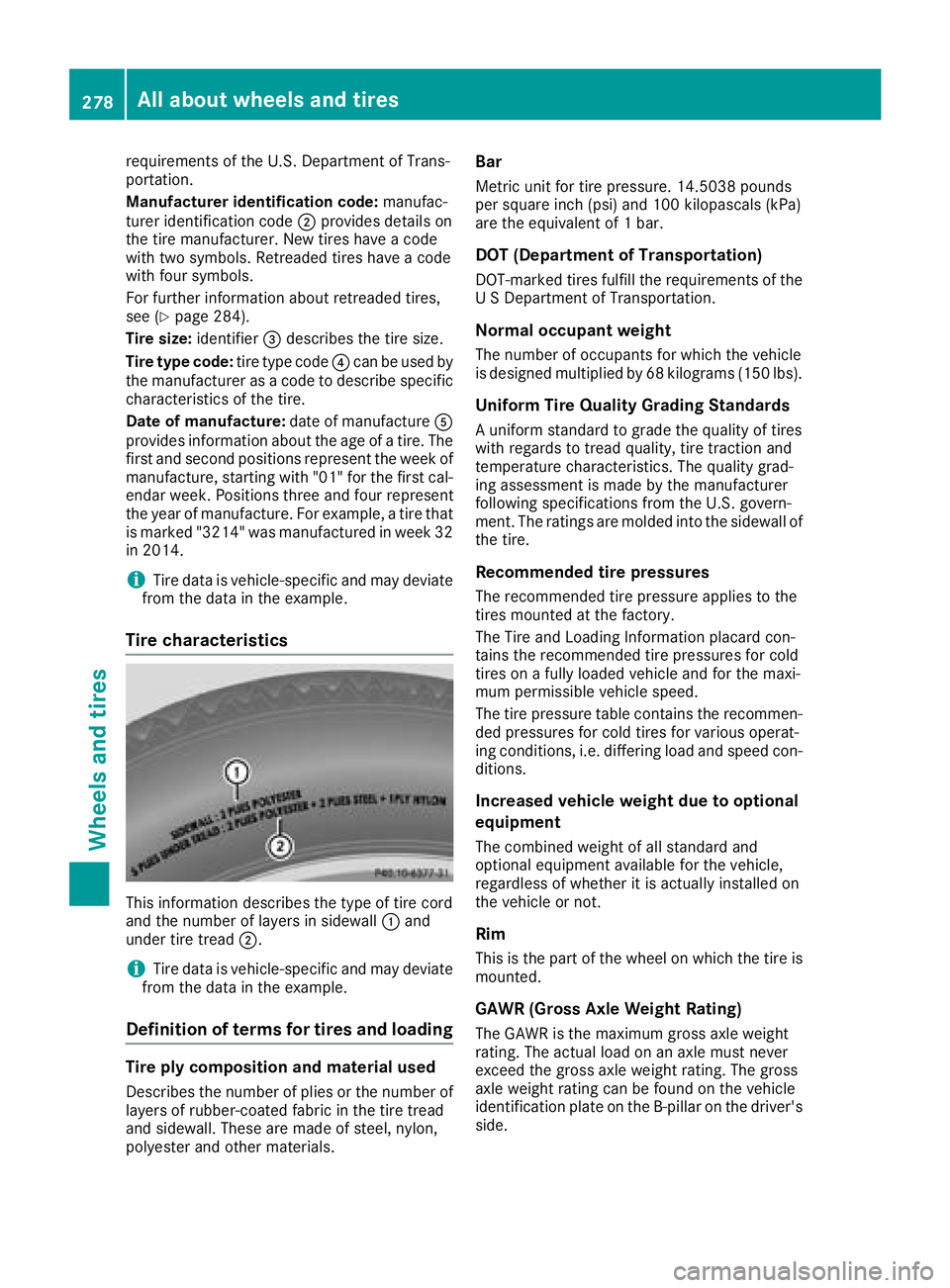
requirements of the U.S. Department of Trans-
portation.
Manufacturer identificationcode: manufac-
turer identification code ;provides details on
the tire manufacturer. New tires have acode
with two symbols. Retreaded tires have acode
with four symbols.
For further informatio nabout retreaded tires,
see (
Ypag e284).
Tire size: identifier=describes the tire size.
Tire type code: tire type code?can be used by
the manufacturer as acode to describes pecific
characteristics of the tire.
Date of manufacture: date of manufactureA
provides informatio nabout the age of atire. The
first and second positions represent the weeko f
manufacture, starting with "01" for the first cal-
endar week. Positions three and four represent
the yea rofmanufacture. For example, atire that
is marked "3214" was manufactured in week3 2
in 2014.
iTire data is vehicle-specific and may deviate
from the data in the example.
Tire characteristics
This informatio ndescribes the type of tire cord
and the number of layers in sidewall :and
under tire tread ;.
iTire data is vehicle-specific and may deviate
from the data in the example.
Definition of terms for tires and loading
Tire ply compositio nand material used
Describes the number of plies or the number of
layers of rubber-coated fabricint he tire tread
and sidewall. These are made of steel, nylon,
polyester and other materials.
Bar
Metric unit for tire pressure. 14.5038 pounds
per square inch (psi)a nd 100 kilopascals(kPa)
are the equivalent of 1bar.
DOT (Department of Transportation)
DOT-marked tires fulfill the requirements of the
USD epartment of Transportation.
Normal occupant weight
The number of occupants for which the vehicle
is designed multiplied by 68 kilograms (150 lbs).
Uniform Tire Quality Grading Standards
Auniform standard to grad ethe quality of tires
with regards to tread quality,t ire traction and
temperature characteristics. The quality grad-
ing assessment is made by the manufacturer
following specifications from the U.S. govern-
ment. The ratings are moldedi nto the sidewallof
the tire.
Recommended tire pressures
The recommended tire pressure appliestot he
tires mounted at the factory.
The Tire and Loading Information placard con-
tains the recommended tire pressures for cold
tires on afullyloaded vehiclea nd for the maxi-
mum permissiblev ehiclespeed.
The tire pressure table contains the recommen-
ded pressures for cold tires for various operat-
ing conditions, i.e. differing loada nd speedcon-
ditions.
Increased vehicle weight due to optional
equipment
The combined weight of all standard and
optionale quipment available for the vehicle,
regardless of whetheritisa ctually installed on
the vehicleorn ot.
Rim
This is the part of the wheelonw hich the tire is
mounted.
GAWR (Gross Axl eWeight Rating)
The GAWR is the maximu mgross axle weight
rating. The actua lloadonana xle must never
exceed the gross axle weight rating. The gross
axle weight rating can be found on the vehicle
identification plate on the B-pillar on the dri
ver's
side.
278Alla bout wheels and tires
Wheels and tires